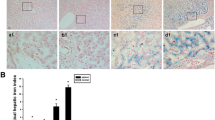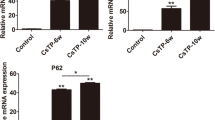Abstract
To investigate the injury and pathogenesis of Clonorchis sinensis (C. sinensis) to hepatocytes, the liver samples from Wistar rats and patients with C. sinensis infection were examined. The typical histopathological findings of clonorchiasis were observed in rats 4 to 12 weeks postinfection, and majority hepatocytes exhibited hydropic degeneration, even some hepatocytes showed densely condensed nuclei suggesting apoptosis in liver tissue. Apoptosis was found around the central vein or portal areas of liver tissue in rat infected with C. sinensis by transferase uridyl nick end labeling (TUNEL) assay. Compared with normal control, TUNEL-positive cells in liver tissue increase from 4 to 12 weeks postinfection with the peak at 8 weeks. Furthermore, the expression of mRNA and protein of Fas, FasL, and caspase-3 was stronger in infected group than normal control using semiquantitative reverse transcriptase polymerase chain reaction (RT-PCR) and immunohistochemistry. Autopsy specimens from four patients infected with C. sinensis have the same findings detected by histopathology, TUNEL, and immunohistochemistry. These findings suggest that the C. sinensis can stimulate both hepatocytic apoptosis and hydropic degeneration that may be responsible for relationship between clinical manifestations and liver lesions in patients with clonorchiasis. These data also indicate a role for Fas/FasL-mediated pathway in the apoptosis that occurs in response to C. sinensis infection.




Similar content being viewed by others
References
Amornpunt S, Sarasombath S, Sirisinha S (1991) Production and characterization of monoclonal antibodies against the excretory-secretory antigen of the liver fluke (Opisthorchis viverrini). Int J Parasitol 21:421–428
Chen L, Rao KV, He YX, Ramaswamy K (2002) Skin-stage schistosomula of Schistosoma mansoni produce an apoptosis-inducing factor that can cause apoptosis of T cells. J Biol Chem 277:34329–34335
Cho PY, Lee MJ, Kim TI, Kang SY, Hong SJ (2006) Expressed sequence tag analysis of adult Clonorchis sinensis, the Chinese live fluke. Parasitol Res 99:602–608
Choi YK, Yoon BI, Won YS, Lee CH, Hyun BH, Kim HC, Oh GT, Kim DY (2003) Cytokine responses in mice infected with Clonorchis sinensis. Parasitol Res 91(2):87–93
Choi BI, Han JK, Hong ST, Lee KH (2004a) Clonorchiasis and cholangiocarcinoma: etiologic relationship and imaging diagnosis. Clin Microbiol Rev 17:540–552
Choi D, Hong ST, Li S, Chung BS, Lim JH, Lee SH (2004b) Bile duct changes in rats reinfected with Clonorchis sinensis. Korean J Parasitol 42:7–17
Choi D, Lim JH, Lee KT, Lee JK, Choi SH, Heo JS, Jang KT, Lee NY, Kim S, Hong ST (2006) Cholangiocarcinoma and Clonorchis sinensis infection: a case-control study in Korea. J Hepatol 44:1066–1073
Fan PC (1998) Viability of metacercariae of Clonorchis sinensis in frozen or salted freshwater fish. Int J Parasitol 28:603–605
Guha M, Kumar S, Choubey V, Maity P, Bandyopadhyay U (2006) Apoptosis in liver during malaria: role of oxidative stress and implication of mitochondrial pathway. FASEB J 20:1224–1226
Hasnain SE, Begum R, Ramaiah KV, Sahdev S, Shajil EM, Taneja TK, Mohan M, Athar M, Sah NK, Krishnaveni M (2003) Host-pathogen interactions during apoptosis. J Biosci 28:349–358
Hong ST (2003) Clonorchis sinensis. In: Miliotis MD, Bier JW (eds) International handbook of foodborne pathogens. Marcel Dekker, New York, pp 581–592
Hong SJ, Woo HC, Chung MH, Ahn JH, Moon YS, Choi CH (1994) Liver function in Clonorchis sinensis-infected rabbits. Korean J Parasitol 32:177–183
Hu MS, Schwartzman JD, Yeaman GR, Collins J, Seguin R, Khan IA, Kasper LH (1999) Fas–FasL interaction involved in pathogenesis of ocular toxoplasmosis in mice. Infect Immun 67:928–935
Kamitani W, Shoya Y, Kobayashi T, Watanabe M, Lee BJ, Zhang G, Tomonaga K, Ikuta K (2001) Borna disease virus phosphoprotein binds a neurite outgrowth factor, amphoterin/HMG-1. J Virol 75:8742–8751
Kim YJ, Choi MH, Hong ST, Bae YM (2007) Proliferative effects of excretory/secretory products from Clonorchis sinensis on the human epithelial cell line HEK293 via regulation of the transcription factor E2F1. Parasitol Res 102:411–417
Koeppel TA, Thies JC, Schemmer P, Trauner M, Gebhard MM, Otto G, Post S (1997) Inhibition of nitric oxide synthesis in ischemia/reperfusion of the rat liver is followed by impairment of hepatic microvascular blood flow. J Hepatol 27:163–169
Luder CG, Gross U (2005) Apoptosis and its modulation during infection with Toxoplasma gondii: molecular mechanisms and role in pathogenesis. Curr Top Microbiol Immunol 289:219–237
Mele R, Gomez Morales MA, Tosini F, Pozio E (2004) Cryptosporidium parvum at different developmental stages modulates host cell apoptosis in vitro. Infect Immun 72:6061–6067
Nagata S, Golstein P (1995) The Fas death factor. Science 267:1449–1456
Nishikawa Y, Makala L, Otsuka H, Mikami T, Nagasawa H (2002) Mechanisms of apoptosis in murine fibroblasts by two intracellular protozoan parasites, Toxoplasma gondii and Neospora caninum. Parasite Immunol 24:347–354
Ogasawara J, Watanabe-Fukunaga R, Adachi M, Matsuzawa A, Kasugai T, Kitamura Y, Itoh N, Suda T, Nagata S (1993) Lethal effect of the anti-Fas antibody in mice. Nature 364:806–809
Quan FS, Lee JB, Bae JS, Ohwatari N, Min YK, Yang HM (2005) Resistance to reinfection in rats induced by irradiated metacercariae of Clonorchis sinensis. Mem Inst Oswaldo Cruz 100:549–554
Raff M (1998) Cell suicide for beginners. Nature 396:119–122
Rim HJ (2005) Clonorchiasis: an update. J Helminthol 79:269–281
Sohn WM, Zhang H, Choi MH, Hong ST (2006) Susceptibility of experimental animals to reinfection with Clonorchis sinensis. Korean J Parasitol 44:163–166
Wang KX, Zhang RB, Cui YB, Tian Y, Cai R, Li CP (2004) Clinical and epidemiological features of patients with clonorchiasis. World J Gastroenterol 10:446–448
Yoon BI, Choi YK, Kim DY, Hyun BH, Joo KH, Rim HJ, Lee JH (2001) Infectivity and pathological changes in murine clonorchiasis: comparison in immunocompetent and immunodeficient mice. J Vet Med Sci 63:421–425
Zhou Z, Sun X, Kang YJ (2001) Ethanol-induced apoptosis in mouse liver: Fas- and cytochrome c-mediated caspase-3 activation pathway. Am J Pathol 159:329–338
Acknowledgments
This work was supported partly with grants from National Natural Science Foundation of China (J0730858), Outstanding Youth Foundation of Heilongjiang Province (JC04-05), Foundation of Heilongjiang Provincial Health Bureau (2005-37) and Youth Foundation of Harbin Medical University (060026). The experiments comply with the current laws of the country in which the experiments were performed.
Author information
Authors and Affiliations
Corresponding author
Additional information
Drs. Xiaoli Zhang and Zhanfeng Jin contributed equally to this work.
Rights and permissions
About this article
Cite this article
Zhang, X., Jin, Z., Da, R. et al. Fas/FasL-dependent apoptosis of hepatocytes induced in rat and patients with Clonorchis sinensis infection. Parasitol Res 103, 393–399 (2008). https://doi.org/10.1007/s00436-008-0985-5
Received:
Accepted:
Published:
Issue Date:
DOI: https://doi.org/10.1007/s00436-008-0985-5




